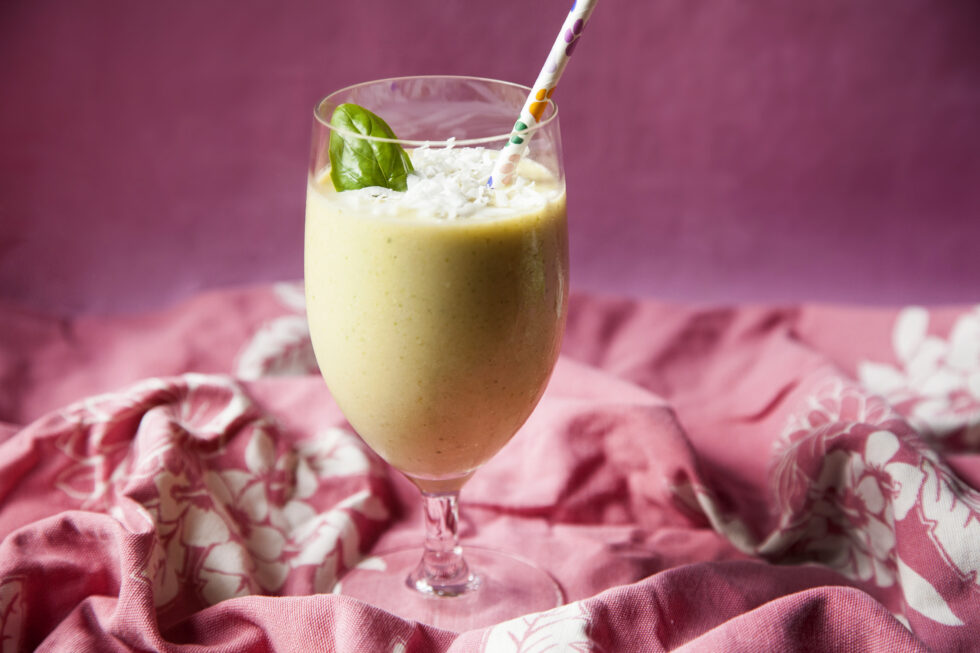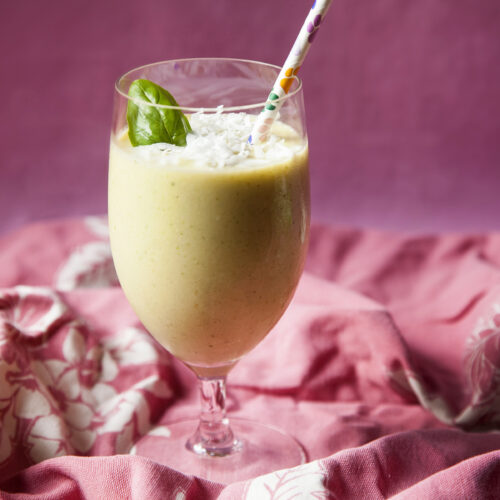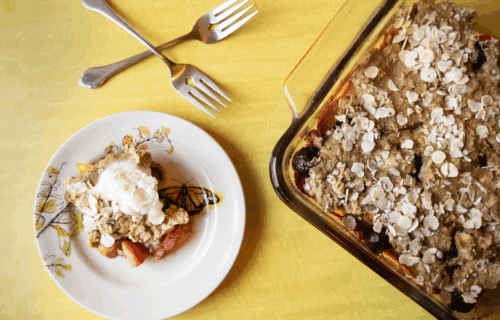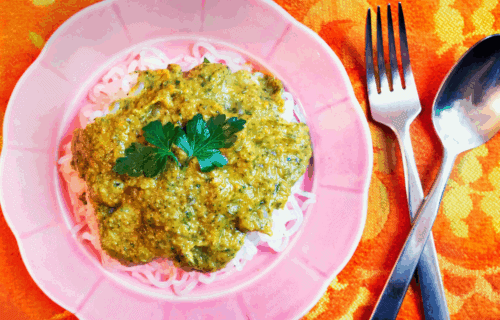
Easy Mango-Basil Low Histamine Smoothie Recipe (also Low Oxalate, Low Lectin)
Having low histamine breakfast options is great! It’s even better if those breakfast options are quick and easy. That’s why I love this low histamine smoothie recipe.
Some days, I’m busy. Really busy. You can probably relate!
On those days, I want to start my day with an easy to make breakfast.
For something quick, easy, and nutritious, I really like smoothies.
I’ve made fruit smoothies with blueberries and tart cherries.
I’ve made green smoothies with kale and apples.
Just like with soups, smoothies offer endless possibilities.
The low histamine smoothie recipe I’ve got for you today comes from Jen Colletti.
She’s created a tasty and satisfying mango-basil recipe.
It’s:
- low histamine
- medium oxalate
- low lectin
- gluten-free
It’s also vegan! That’s good news if you are going dairy-free for Phase 1 of the low histamine diet.
She used delicious ingredients that satisfy your taste buds and your hunger.
Mango reminds me of summer and tropical drinks. It’s light and refreshing.
Jen paired this nicely with earthy basil, rich macadamia nuts, and silky coconut milk.
Is your mouth watering yet? Mine is just thinking about it!
If that’s not enough to tempt you, check out how adding some of these simple ingredients to your dishes can help to support your health.
And take a look at why you’ll be better off making your own smoothie than buying one at the store or restaurant.
Finding Low Histamine Smoothie Ingredients
Smoothies don’t take long to make. But still, you may be thinking you can just pick one up from the store.
Unfortunately, even the “healthier” pre-made versions may not be the best choices if you have Mast Cell Activation Syndrome or Histamine Intolerance.
Here’s what you should watch out for.
High Histamine Ingredients
I pulled up the ingredients list to a popular brand of store-bought smoothie.
Check out what the mango flavor has:
- Banana puree (high histamine)
- Orange juice (high histamine)
- Natural flavors
Here’s what you should know about natural flavors. They may not be so natural!
To be called a natural flavor, the base source must be from a plant or animal.
But from there, companies can add natural or synthetic chemicals. You don’t really know what you’re getting with “natural flavors.”
That’s a bottled smoothie. What about smoothies from a juice or smoothie bar?
Unless you ask questions, you don’t know what you’re getting there either.
In addition to knowing exactly what the ingredients are, you’ll want to know how they prepare and store them.
If the ingredients are only low histamine fruits, ice, and a liquid you can tolerate, you might be fine.
But I’ve seen some places add ice cream!
And some places may add sugar to their fruits.
You might even get a smoothie made from a powder mix. Who knows what’s in that?
When it comes to histamine, you must consider how the ingredients are stored and prepared, too.
You’ll often see prep stations at fast food smoothie places.
You don’t know how long those ingredients have been sitting “chilled” but not refrigerated. And some foods like fruits have been pre-cut.
Both temperature and exposed surface area can increase histamine levels.
If you’re really sensitive, like a lot of my private clients, these factors can make a difference.
But it’s easy to whip up your own organic, low histamine smoothie in minutes!
Here are a couple things to note when making smoothies at home.
Collagen and Oxalate Intolerance
You may be wondering if you can add collagen and protein powders to your smoothies.
Here are a few things to keep in mind before you blend those in.
Collagen is high histamine.
And collagen is high in the amino acid, hydroxyproline.
Hydroxyproline can be converted to oxalates in your body.
If you have Oxalate Intolerance, you’re probably working on lowering your oxalate load to reduce your related symptoms.
So, skip the dietary collagen supplements if you are currently dealing with Oxalate Intolerance.
Protein Powders and Food Intolerances
I receive a lot of questions asking which protein powders I would suggest.
Unfortunately, I haven’t found a protein powder that checks all these boxes:
Most protein powders will be high in salicylates.
Rice and pea protein are lectins.
Hemp protein is high oxalate.
Soy is high histamine.
I’ve found one that is lower histamine with lower levels of salicylates and oxalates.
But it does have rice and pea protein. So, it won’t be well tolerated with Lectin Intolerance.
However, if you aren’t concerned about lectins and you’re not hypersensitive to histamine, you can look into this one to see if it might be right for you. It does have magnesium citrate which may cause a histamine reaction for some.
And if you don’t have trouble with oxalates, this hemp protein is one to consider.

Now you know a few things to avoid. Next, look at some things you’ll be happy to include!
Health-Supporting Benefits of Mango-Basil Smoothie Ingredients
I like to give you some basic info on the health benefits you’ll get with the foods in each recipe I share.
That way you’ll know it’s a good food to add to your other dishes, too. All the little things you do to support your health add up.
Take a look at what benefits these ingredients can offer.
Basil
Though they may be small in size, herbs like basil have big benefits.
Top nutrients found in basil include:
Calcium
- Needed for your bones
- Helps with proper functioning of the heart and muscles
- Important for cell signaling
Iron
- Needed for energy
- Aids in GI processes
- Used in immune system functions
Magnesium
- Cofactor for 300+ enzymes used in different body processes, including DAO (diamine oxidase), a histamine degrading enzyme.
Potassium
- Needed for nerve signaling
- Regulates fluids in the body
Vitamin C
- Cofactor for DAO
- Supports immune system
- Shown to have antioxidant properties
Basil has also been shown to have these properties:
- Antimicrobial
- Antiinflammatory
- Antioxidant
- Antihistamine
And one animal study showed basil to lower glucose. That can help with blood sugar regulation and diabetes.
One last thing about basil.
Basil is rich in compounds that help make nitric oxide.
And here’s why that’s important. Nitric oxide is a mast cell stabilizer. Great news if you have Mast Cell Activation Syndrome.
All of these great benefits are why I include basil in low histamine recipes like these:
Mango
Frozen mango cubes are the easiest and most accessible way to go for this recipe. But you can use fresh mango, too. If you use fresh, you might want to add a couple small ice cubes for consistency.
I love the taste of mango. I like it in fruit salads, drinks, and I even made a low-histamine mango “ice-cream.”
And mango has so many good benefits, too.
Some of the top nutrients in basil are also the top nutrients in mango.
- Calcium
- Magnesium
- Potassium
- Vitamin C
Mango also contains a substance called mangiferin. In studies, this has been shown to help support healthy cholesterol and can help lower blood sugar levels.
Mango is also rich in quercetin, which has been shown to have mast cell stabilizing qualities and to inhibit histamine release.
Some other great low histamine recipes that use mango are:
- Mango Ice Cream – Low Oxalate & Low Lectin
- Mango Blueberry Basil Salad – Low Oxalate & Low Lectin
Nuts
Nuts are a type of superfood. Superfoods can be meats, fruits, veggies, or in this case, nuts.
The term superfoods isn’t really a scientific classification. But it generally means that these foods are nutrient dense.
In addition to numerous vitamins, nuts are also a good source of:
Omega-3 fatty acids
- Shown to be anti-inflammatory
- Can have mast cell stabilizing properties
- Shown to help with heart health
Fiber
- Aids in digestion
- Feeds healthy gut bacteria
- Shown to boost the immune system
- Shown to help reduce inflammation
Protein
- Needed for energy
- Used by the body to carry oxygen to your cells
- Important for immune health
- Has been shown to lower blood glucose in those with type 2 diabetes
- Helps you feel full
With all those benefits, why wouldn’t you want to include some of those foods in your daily meals?
Got 2 minutes? That’s all you need to make this delicious and health-supporting mango-basil low histamine smoothie!

Mango-Basil Low Histamine Smoothie Recipe
Ingredients
- ½ cup Frozen Mango Cubes
- 1 cup Native Forest Coconut Milk
- 3-4 whole Pecans or Macadamia Nuts
- ⅙ cup Filtered Water
- 2-3 Fresh Organic Basil about 2-3 inches long, torn
- 2-3 drops Stevia
- ⅙ teaspoon Redmond Real Salt
- 1 teaspoon Shredded Coconut unsweetened (optional)
Instructions
- Add mango, coconut milk, nuts, water, basil, stevia, and salt to the high-speed blender.
- Blend for 30-45 seconds.
- Pour into a tall glass.
- Garnish with shredded coconut (optional).
Notes
- If you really love the taste of basil, go with 3 leaves. Otherwise stick with 2.
- You can add more Stevia or a pinch of monk fruit powder if you like your smoothies sweeter.
- If you like a thinner smoothie, you can add more water. Add it slowly at about 1/8 of a cup at a time.
- Shredded coconut will have a little histamine. You can introduce this if you are in Phase 2 of the Low Histamine Diet.
- Nutritional information includes shredded coconut topping.
Nutrition
What low histamine smoothies have you made? Comment below with your favorite combinations!
More Light and Cool Low Histamine Treats
- Frozen Vanilla Coffee Cooler – Low Lectin, Low Oxalate, Low FODMAP
- Mango Blueberry Basil Salad – Low Oxalate and Low Lectin
- Cherry Smoothie – Low Oxalate and Low Lectin
- Low FODMAP Ice Cream – Low Oxalate and Low Lectin
- Easy Mango Ice Cream – Low Oxalate, Low Lectin, Low FODMAP
- Apple Pie Smoothie – Low Oxalate and Low Lectin
Some links in this website are affiliate links, which means Mast Cell 360 may make a very small commission if you purchase through the link. It never costs you any more to purchase through the links, and we try to find the best deals we can. We only recommend products that we love and use personally or use in the Mast Cell 360 practice. Any commissions help support the newsletter, website, and ongoing research so Mast Cell 360 can continue to offer you free tips, recipes, and info. Thank you for your support!
References
Brkić, D., et al. (2017). NITRATE IN LEAFY GREEN VEGETABLES AND ESTIMATED INTAKE. African journal of traditional, complementary, and alternative medicines : AJTCAM, 14(3), 31–41. https://doi.org/10.21010/ajtcam.v14i3.4
Carr, A. C., & Maggini, S. (2017). Vitamin C and Immune Function. Nutrients, 9(11), 1211. https://doi.org/10.3390/nu9111211
Coleman J. W. (2002). Nitric oxide: a regulator of mast cell activation and mast cell-mediated inflammation. Clinical and experimental immunology, 129(1), 4–10. https://doi.org/10.1046/j.1365-2249.2002.01918.x
Fargue, S., et al. (2018). Hydroxyproline Metabolism and Oxalate Synthesis in Primary Hyperoxaluria. Journal of the American Society of Nephrology : JASN, 29(6), 1615–1623. https://doi.org/10.1681/ASN.2017040390
Gannon, M. C., et al. (2003). An increase in dietary protein improves the blood glucose response in persons with type 2 diabetes. The American journal of clinical nutrition, 78(4), 734–741. https://doi.org/10.1093/ajcn/78.4.734
Godman, H. (2013, May 2). Extra protein is a decent dietary choice, but don’t overdo it. Harvard Health. https://www.health.harvard.edu/blog/extra-protein-is-a-decent-dietary-choice-but-dont-overdo-it-201305016145
Hagenlocher, Y., & Lorentz, A. (2015, January 1). Immunomodulation of mast cells by nutrients. ScienceDirect. Retrieved November 8, 2021, from https://www.sciencedirect.com/science/article/abs/pii/
Harvard T.H. Chan School of Public Health. (2019, May 22). Omega-3 Fatty Acids: An Essential Contribution. The Nutrition Source. https://www.hsph.harvard.edu/nutritionsource/what-should-you-eat/fats-and-cholesterol/types-of-fat/omega-3-fats/
Linsha Ma , et al. Nitrate and Nitrite in Health and Disease. Aging and disease. 2018, 9(5): 938-945 https://doi.org/10.14336/AD.2017.1207
Ma, Y., et al. (2008). Association between dietary fiber and markers of systemic inflammation in the Women’s Health Initiative Observational Study. Nutrition (Burbank, Los Angeles County, Calif.), 24(10), 941–949. https://doi.org/10.1016/j.nut.2008.04.005
Mayo Clinic Staff. (2021, January 6). Dietary fiber: Essential for a healthy diet. Mayo Clinic. Retrieved January 21, 2022, from https://www.mayoclinic.org/healthy-lifestyle/nutrition-and-healthy-eating/in-depth/fiber/art-20043983?reDate=22012022
Mlcek, J., et al. (2016). Quercetin and Its Anti-Allergic Immune Response. Molecules (Basel, Switzerland), 21(5), 623. https://doi.org/10.3390/molecules21050623
Muruganandan, S., et al. (2005). Effect of mangiferin on hyperglycemia and atherogenicity in streptozotocin diabetic rats. Journal of ethnopharmacology, 97(3), 497–501. https://doi.org/10.1016/j.jep.2004.12.010
National Institutes of Health. (02–06-22). Office of Dietary Supplements – Magnesium. Retrieved June 10, 2022, from https://ods.od.nih.gov/factsheets/Magnesium-HealthProfessional/#:%7E:text=Magnesium
Shahrajabian, M. H., Sun, W., & Cheng, Q. (2020). Chemical components and pharmacological benefits of Basil (Ocimum basilicum): a review. International Journal of Food Properties, 23(1), 1961–1970. https://doi.org/10.1080/10942912.2020.1828456
Tamme, T., et al. (2010). Nitrate in leafy vegetables, culinary herbs, and cucumber grown under cover in Estonia: content and intake. Food additives & contaminants. Part B, Surveillance, 3(2), 108–113. https://doi.org/10.1080/19440041003725944
University of Illinois at Urbana-Champaign. (2010, March 17). An apple a day? Study shows soluble fiber boosts immune system. ScienceDaily. https://www.sciencedaily.com/releases/2010/03.htm
USDA. (2019a, April 1). FoodData Central. US Department of Agriculture. Retrieved June 10, 2022, from https://fdc.nal.usda.gov/fdc-app.html#/food-details/172232/nutrients
USDA. (2019b, April 1). FoodData Central. US Department of Agriculture. Retrieved June 10, 2022, from https://fdc.nal.usda.gov/fdc-app.html#/food-details/169910/nutrients
Widjaja, S. S., Rusdiana, & Savira, M. (2019). Glucose Lowering Effect of Basil Leaves in Diabetic Rats. Open access Macedonian journal of medical sciences, 7(9), 1415–1417. https://doi.org/10.3889/oamjms.2019.293




Any substitution suggestions for the coconut milk? My heart dr. says no to anything coconut except on my skin. Thx, Momma Bear
Any type of milk that you can tolerate should be fine. You might try a rice milk if that works for you. Hope you enjoy it!
I don’t understand your promotion of nuts. Everything I have read says NO NUTS for mast cell patients. NO NUTS for many reasons, but especially the presence of mold. If I could eat nuts, I wouldn’t be worried about starving when I’m out in the world. But I can’t anymore. Why do you say that mast cell patients should eat nuts? I am so confused about so many contradictions I read when trying to earn about managing mast cell symptoms.
Hello Anne,
Good question! Yes, food lists can be conflicting and confusing. Partly because MCAS is not well recognized or widely understood, and part of it is the way food lists are often put together (for examples studies may lump all reactions together when compiling lists, when a reaction may be due to histamine, lectins, FODMAPS, etc). All of the Mast Cell 360 food lists are based on research and experience with hundreds of clients.
Beth is a big advocate for not dropping healthful foods unnecessarily. What that looks like for any single person is going to be individual. We need healthy fats to absorb nutrients and for our bodies to function properly. Low histamine nuts, like macadamia or pecans (the latter should be salted, soaked, and dried to address mold), can be a good source of fats and many nutrients for some people with MCAS. Coconut can likewise be a good substitute for many who don’t tolerate dairy. With limited diets people need options based off our own particular tolerances.
I hope that helps clear things up a bit. For more information on food lists, including a low histamine food list, please see: https://mastcell360.com/low-histamine-foods-list/
Best,
Kam